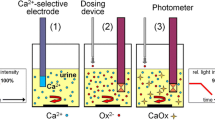Summary
Urinary oxalate excretion has been measured by a specific enzymatic method in normal subjects and stone formers with idiopathic hypercalciuria. In every group studied urinary oxalate was higher in the summer than in the winter. These differences were slight and not significant in normal subjects but were considerable and statistically significant in the stone formers both untreated and when treated with thiazide. Thiazides raise urinary oxalate only very slightly but cellulose phosphate leads to large rises in urinary oxalate both in the summer and the winter. The highest values of urinary oxalate were seen in the summer in patients treated with cellulose phosphate. The mean rise in this group was 70% above normal and this must be viewed with some anxiety.
Similar content being viewed by others
References
Blacklock, N. J., Macleod, M. A.: The effect of cellulose phosphate on intestinal absorption and urinary excretion of calcium. British Journal of Urology 46, 385 (1974)
Dent, C. E., Harper, C. M., Parfitt, A. M.: The effect of cellulose phosphate on calcium metabolism in patients with hypercalciuria. Clinical Science 27, 417 (1964)
Glazenburg, J.: The effect of hydrochlorothiazide on the renal excretion of oxalic acid and on the formation of oxalate stones in the urinary tract. Archivum Chirurgicum Neerlandicum 23, 217 (1971)
Hallson, P. C., Kasidas, G. P., Rose, G. A.: Seasonal variations in urinary excretion of calcium and oxalate in normal subjects and in patients with idiopathic hypercalciuria. British Journal of Urology (in press)
Hallson, P. C., Rose, G. A.: A simplified and rapid enzymatic method for the determination of urinary oxalate. Clinica Chimica Acta 55, 29 (1974)
Hayashi, Y., Kaplan, R. A., Pak, C. Y. C.: Effect of sodium cellulose phosphate therapy on crystallisation of calcium oxalate in urine. Metabolism 24, 1273 (1975)
Hodgkinson, A.: Relations between oxalic acid, calcium, magnesium and creatinine excretion in normal men and male patients with calcium oxalate kidney stones. Clinical Science and Molecular Medicine 46, 357 (1974)
Pak, C. Y. C., Delea, C. S., Bartter, F. C.: Successful treatment of recurrent nephrolithiasis (calcium stones) with cellulose phosphate. New England Journal of Medicine 290, 175 (1974)
Pietrek, J., Kokot, F.: Treatment of patients with calcium containing renal stones with cellulose phosphate. British Journal of Urology 45, 136 (1973)
Pinto, B., Crespi, G., Sole-Balcells, Barcelo, P.: Patterns of oxalate metabolism in recurrent oxalate stone formers. Kidney International 5, 285 (1974)
Rapado, A., Delatte, L. C., Villarino, J. A., Martin, J. A. S.: Tratamiento de la hipercalciuria idiopatica con cellulosa fosfato sodica. Revista Clinca Española 119, 61 (1970)
Revusova, V., Zvara, V., Gratzlova, J.: Urinary oxalate excretion in patients with urolithiasis. Urologia Internationalis 26, 277 (1971)
Robertson, W. G., Peacock, M., Marshall, R. W., Speed, R., Nordin, B. E. C.: Seasonal variations in the composition of urine in relation to calcium stone-formation. Clinical Science and Molecular Medicine 49, 597 (1975)
Rose, G. A., Hallson, P. C.: Idiopathic hypercalciuria-effect of treatment upon urinary calcium and oxalate. Pathogenese und Klinik der Harnsteine IV. Symposium in Bonn 1974. Darmstadt: Steinkopff 1976
Rose, G. A., Harrison, A. R.: The incidence, investigation and treatment of idiopathic hypercalciuria. British Journal of Urology 46, 261 (1974)
Thomas, J., Melon, J. M., Thomas, E., Steg, A., Desgrez, P., Alboulker, P.: Données récentes sur l'élimination urinaires de l'acide oxalique dans la lithiase rénale oxalique. Annales urologiques 6, 31 (1972)
Villarino, J. A., Rapado, A., Traba, M. E., Mendoza, H. J. C.: La determinacion de acido oxalica en la orina y su influencia por la dieta. Revista Clinica Española 25, 19 (1972)
Westbury, E. J.: Some observations on the quantitative analysis of over 1000 urinary calculi. British Journal of Urology 46, 214 (1974)
Yendt, E. R., Cohanim, M.: Ten years experience with the use of thiazides in the prevention of kidney stones. Transactions of the American Clinical and Climatological Association. 85, 65 (1973)
Yendt, E. R., Guay, G. F., Garcia, D. A.: The use of thiazide in the prevention of renal calculi. Canadian Medical Association Journal 102, 614 (1970)
Author information
Authors and Affiliations
Rights and permissions
About this article
Cite this article
Hallson, P.C., Kasidas, G.P. & Alan Rose, G. Urinary oxalate in summer and winter in normal subjects and in stone-forming patients with idiopathic hypercalciuria, both untreated and treated with thiazide and/or cellulose phosphate. Urol. Res. 4, 169–173 (1976). https://doi.org/10.1007/BF00262350
Received:
Issue Date:
DOI: https://doi.org/10.1007/BF00262350




